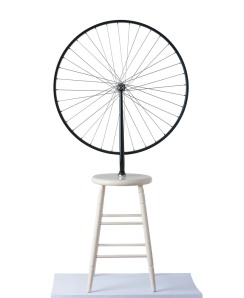This post is a variation on Zeteo is Reading. Here, Zeteo is Looking.
On the first Saturday of each month, the Brooklyn Museum is free from 5 to 11pm. Viva Brooklyn! was the theme for October’s First Saturday with thirteen free events throughout the museum from panel discussions, gallery talks, to hands-on art making for all ages. On the program were three different Latino music groups that alternated in the 1st floor Pavilion and three bicycle art projects outside the museum on the Front Plaza. Fortunately, the all-day rain had stopped and it was a glorious, sun-filled setting to enjoy art.
Charlie Wirene set up two stationary-regular bikes attached to a battery. When the bikes are ridden by anyone who wishes to participate, energy is transferred to the battery. If such a mechanism were in a home, one could conceivably generate power for all electronics, still not enough to eliminate ConEd. Wirene is friendly and graciously patient with all questions and is present in front of the Museum every Saturday—if one wants to “exercise” and contribute!
On the other side of the Plaza, Ethan Barnett performed conceptual artist Caecilia Tripp’s Music for (prepared) Bicycles by riding a sonic bike (a red Schwinn) that had electric guitar strings in place of some spokes on the wheels with playing cards attached and connected to an audio system. Barnett rode the bike for 30 minutes over a 12 ‘ by 8’ blank canvas and through four plastic panels covered in black paint at each corner. As he pedaled the bike with great agility and sounded the bell intermittently, black curvilinear lines piled up on the surface of the canvas and the sound of the music from the wheels was heard simultaneously. Inspired by John Cage’s delight in street sounds and the ideas of Marcel Duchamp (one thinks of his famous readymade Bicycle Wheel, 1913), Tripp brings together these two artists with a lively and mesmerizing new spin.
When Ethan completed his bicycle painting, artist Miguel Luciano took over the space on the Plaza with his bicycle-food cart that is intended to commemorate Latino street vendors. The cart, a brilliant shiny orange, is designed like a car but borders on looking anthropomorphic while the bicycle is polished stainless steel. Luciano equipped the cart to make flavored ices and gave them out free to the crowd. Salsa music played from the cart and, with great abandon, people were dancing!
If one wanted to take home a souvenir from this celebration of the bicycle, there is one for sale at the museum. Chinese artist Ai Weiwei designed the bike to pay homage to the dominant form of transportation in China before the growth of the middle class and the advent of the car. (He uses bikes, sometimes a thousand or more, in his installations.) The bike, an edition of 60, is all stainless steel with white tires and trim and stunning in the simplicity of its form. For the amount of $27,500, one can own an Ai Weiwei work of art!
—Gayle Rodda Kurtz, Zeteo Associate
Note: Apologies to the reader for not having photos of these events. I have, up to this past weekend, not felt the need to have an iPhone. On Saturday, with great frustration at my predicament (never occurred to me to take a camera to the museum), I decided the time had come to fall in line with everyone else.
Credits:
Image of Miguel Luciano with his bicycle-food cart. Marcel Duchamp, Bicycle Wheel, 1913 (1964 replica, original lost), height 49 5/8″.



Leave a comment